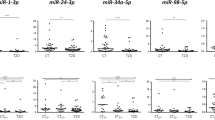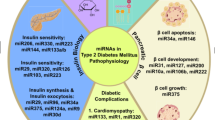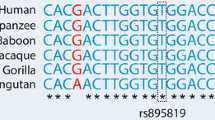Abstract
Aims
Type 1 diabetes mellitus (T1DM) is characterized by severe autoimmune destruction of pancreatic beta-cells. The triggering of autoimmunity against beta-cells is probably caused by a combination of environmental and genetic risk factors. Even though much is known about the genetic of T1DM, more information is needed to completely unravel this tangled disease. MicroRNAs (miRNAs) are a class of small noncoding RNAs molecules that negatively regulate gene expression by inducing target mRNA cleavage or by inhibiting protein translation. Abnormal miRNA expressions have been described in autoimmune diseases and T1DM. Polymorphisms in genes codifying miRNAs may alter the expression of the corresponding miRNA and, thus, confer susceptibility for a given disease. Therefore, the aim of this study was to investigate whether polymorphisms in genes encoding miR-155, miR-146a, and miR-375 are associated with T1DM.
Methods
Frequencies of the miRNA-146a rs2910164, miRNA-155 rs767649 and miRNA-375 rs6715345 polymorphisms were analyzed in 490 T1DM patients and in 469 nondiabetic subjects.
Results
The miR-146a rs2910164 and miR-155 rs767649 polymorphisms were associated with protection for T1DM, and the strongest association was observed for the dominant model [odds ratio (OR) = 0.557 95% CI 0.355–0.874 and OR = 0.508, 95% CI 0.265–0.973, respectively, after adjustment for age, ethnicity, and risk HLA loci]. However, miR-375 rs6715345 frequencies did not differ between cases and controls.
Conclusion
MiR-146a rs2910164 and miR-155 rs767649 polymorphisms were associated with protection for T1DM.

Similar content being viewed by others
References
American Diabetes Association (2015) Classification and diagnosis of diabetes. Diabetes Care 38(Suppl):S8–S16. doi:10.2337/dc15-S005
van Belle TL, Coppieters KT, von Herrath MG (2011) Type 1 diabetes: etiology, immunology, and therapeutic strategies. Physiol Rev 91(1):79–118. doi:10.1152/physrev.00003.2010
Nguyen C, Varney MD, Harrison LC, Morahan G (2013) Definition of high-risk type 1 diabetes HLA-DR and HLA-DQ types using only three single nucleotide polymorphisms. Diabetes 62(6):2135–2140. doi:10.2337/db12-1398
Pociot F, Lernmark A (2016) Genetic risk factors for type 1 diabetes. Lancet 387(10035):2331–2339. doi:10.1016/S0140-6736(16)30582-7
Bartel DP (2009) MicroRNAs: target recognition and regulatory functions. Cell 136(2):215–233. doi:10.1016/j.cell.2009.01.002
Guay C, Regazzi R (2013) Circulating microRNAs as novel biomarkers for diabetes mellitus. Nat Rev Endocrinol 9(9):513–521. doi:10.1038/nrendo.2013.86
Friedman RC, Farh KK, Burge CB, Bartel DP (2009) Most mammalian mRNAs are conserved targets of microRNAs. Genome Res 19(1):92–105. doi:10.1101/gr.082701.108
Butz H, Kinga N, Racz K, Patocs A (2016) Circulating miRNAs as biomarkers for endocrine disorders. J Endocrinol Invest 39(1):1–10. doi:10.1007/s40618-015-0316-5
Yang M, Ye L, Wang B et al (2015) Decreased miR-146 expression in peripheral blood mononuclear cells is correlated with ongoing islet autoimmunity in type 1 diabetes patients. J Diabetes 7(2):158–165. doi:10.1111/1753-0407.12163
Roggli E, Britan A, Gattesco S et al (2010) Involvement of microRNAs in the cytotoxic effects exerted by proinflammatory cytokines on pancreatic beta-cells. Diabetes 59(4):978–986. doi:10.2337/db09-0881
Churov AV, Oleinik EK, Knip M (2015) MicroRNAs in rheumatoid arthritis: altered expression and diagnostic potential. Autoimmun Rev 14(11):1029–1037. doi:10.1016/j.autrev.2015.07.005
Xu WD, Lu MM, Pan HF, Ye DQ (2012) Association of MicroRNA-146a with autoimmune diseases. Inflammation 35(4):1525–1529. doi:10.1007/s10753-012-9467-0
Taganov KD, Boldin MP, Chang KJ, Baltimore D (2006) NF-kappaB-dependent induction of microRNA miR-146, an inhibitor targeted to signaling proteins of innate immune responses. Proc Natl Acad Sci USA 103(33):12481–12486. doi:10.1073/pnas.0605298103
O’Connell RM, Taganov KD, Boldin MP, Cheng G, Baltimore D (2007) MicroRNA-155 is induced during the macrophage inflammatory response. Proc Natl Acad Sci USA 104(5):1604–1609. doi:10.1073/pnas.0610731104
Baltimore D, Boldin MP, O’Connell RM, Rao DS, Taganov KD (2008) MicroRNAs: new regulators of immune cell development and function. Nat Immunol 9(8):839–845. doi:10.1038/ni.f.209
Faraoni I, Antonetti FR, Cardone J, Bonmassar E (2009) miR-155 gene: a typical multifunctional microRNA. Biochim Biophys Acta 1792(6):497–505. doi:10.1016/j.bbadis.2009.02.013
Rusca N, Monticelli S (2011) MiR-146a in Immunity and Disease. Mol Biol Int 2011:437301. doi:10.4061/2011/437301
Guay C, Roggli E, Nesca V, Jacovetti C, Regazzi R (2011) Diabetes mellitus, a microRNA-related disease? J Lab Clin Med 157(4):253–264. doi:10.1016/j.trsl.2011.01.009
Li X (2014) MiR-375, a microRNA related to diabetes. Gene 533(1):1–4. doi:10.1016/j.gene.2013.09.105
Erener S, Mojibian M, Fox JK, Denroche HC, Kieffer TJ (2013) Circulating miR-375 as a biomarker of β-cell death and diabetes in mice. Endocrinology 154(2):603–608. doi:10.1210/en.2012-1744
Marchand L, Jalabert A, Meugnier E et al (2016) miRNA-375 a sensor of glucotoxicity is altered in the serum of children with newly diagnosed type 1 diabetes. J Diabetes Res 2016:1869082. doi:10.1155/2016/1869082
Nielsen LB, Wang C, Sorensen K et al (2012) Circulating levels of microRNA from children with newly diagnosed type 1 diabetes and healthy controls: evidence that miR-25 associates to residual beta-cell function and glycaemic control during disease progression. Exp Diabetes Res 2012:896362. doi:10.1155/2012/896362
Khamaneh AM, Alipour MR, Sheikhzadeh Hesari F, Ghadiri Soufi F (2015) A signature of microRNA-155 in the pathogenesis of diabetic complications. J Physiol Biochem 71(2):301–309. doi:10.1007/s13105-015-0413-0
Cammaerts S, Strazisar M, De Rijk P, Del Favero J (2015) Genetic variants in microRNA genes: impact on microRNA expression, function, and disease. Front Genet 6:186. doi:10.3389/fgene.2015.00186
Li C, Fu W, Zhang Y et al (2015) Meta-analysis of microRNA-146a rs2910164 G > C polymorphism association with autoimmune diseases susceptibility, an update based on 24 studies. PLoS ONE 10(4):e0121918. doi:10.1371/journal.pone.0121918
Park R, Lee WJ, Ji JD (2016) Association between the three functional miR-146a single-nucleotide polymorphisms, rs2910164, rs57095329, and rs2431697, and autoimmune disease susceptibility: a meta-analysis. Autoimmunity. doi:10.3109/08916934.2016.1171854
Jimenez-Morales S, Gamboa-Becerra R, Baca V et al (2012) MiR-146a polymorphism is associated with asthma but not with systemic lupus erythematosus and juvenile rheumatoid arthritis in Mexican patients. Tissue Antigens 80(4):317–321. doi:10.1111/j.1399-0039.2012.01929.x
von Elm E, Altman DG, Egger M et al (2008) The Strengthening the Reporting of Observational Studies in Epidemiology (STROBE) statement: guidelines for reporting observational studies. J Clin Epidemiol 61(4):344–349. doi:10.1016/j.jclinepi.2007.11.008
Little J, Higgins JP, Ioannidis JP et al (2009) Strengthening the reporting of genetic association studies (STREGA)—an extension of the STROBE statement. Genet Epidemiol 33(7):581–598. doi:10.1002/gepi.20410
Assmann TS, Brondani Lde A, Bauer AC, Canani LH, Crispim D (2014) Polymorphisms in the TLR3 gene are associated with risk for type 1 diabetes mellitus. Eur J Endocrinol 170(4):519–527. doi:10.1530/EJE-13-0963
Gong J, Tong Y, Zhang HM et al (2012) Genome-wide identification of SNPs in microRNA genes and the SNP effects on microRNA target binding and biogenesis. Hum Mutat 33(1):254–263. doi:10.1002/humu.21641
Hsu SD, Chu CH, Tsou AP et al (2008) miRNAMap 2.0: genomic maps of microRNAs in metazoan genomes. Nucleic Acids Res 36(Database issue):D165–169. doi:10.1093/nar/gkm1012
Kaidonis G, Gillies MC, Abhary S et al (2016) A single-nucleotide polymorphism in the MicroRNA-146a gene is associated with diabetic nephropathy and sight-threatening diabetic retinopathy in Caucasian patients. Acta Diabetol. doi:10.1007/s00592-016-0850-4
Ciccacci C, Morganti R, Di Fusco D et al (2014) Common polymorphisms in MIR146a, MIR128a and MIR27a genes contribute to neuropathy susceptibility in type 2 diabetes. Acta Diabetol 51(4):663–671. doi:10.1007/s00592-014-0582-2
Xie K, Ma H, Liang C et al (2015) A functional variant in miR-155 regulation region contributes to lung cancer risk and survival. Oncotarget 6(40):42781–42792. doi:10.18632/oncotarget.5840
Bulik-Sullivan B, Selitsky S, Sethupathy P (2013) Prioritization of genetic variants in the microRNA regulome as functional candidates in genome-wide association studies. Hum Mutat 34(8):1049–1056. doi:10.1002/humu.22337
Nahid MA, Pauley KM, Satoh M, Chan EK (2009) miR-146a is critical for endotoxin-induced tolerance: implication in innate immunity. J Biol Chem 284(50):34590–34599. doi:10.1074/jbc.M109.056317
Nahid MA, Satoh M, Chan EK (2011) MicroRNA in TLR signaling and endotoxin tolerance. Cell Mol Immunol 8(5):388–403. doi:10.1038/cmi.2011.26
Nahid MA, Satoh M, Chan EK (2011) Mechanistic role of microRNA-146a in endotoxin-induced differential cross-regulation of TLR signaling. Open J Immunol 186(3):1723–1734. doi:10.4049/jimmunol.1002311
Doxaki C, Kampranis SC, Eliopoulos AG, Spilianakis C, Tsatsanis C (2015) Coordinated Regulation of miR-155 and miR-146a Genes during Induction of Endotoxin Tolerance in Macrophages. J Immunol 195(12):5750–5761. doi:10.4049/jimmunol.1500615
Gao M, Wang X, Zhang X et al (2015) Attenuation of cardiac dysfunction in polymicrobial sepsis by microRNA-146a is mediated via targeting of IRAK1 and TRAF6 expression. J Immunol 195(2):672–682. doi:10.4049/jimmunol.1403155
Saba R, Sorensen DL, Booth SA (2014) MicroRNA-146a: a dominant, negative regulator of the innate immune response. Front Immunol 5:578. doi:10.3389/fimmu.2014.00578
Meisgen F, Xu Landen N, Wang A et al (2014) MiR-146a negatively regulates TLR2-induced inflammatory responses in keratinocytes. J Invest Dermatol 134(7):1931–1940. doi:10.1038/jid.2014.89
Al-Quraishy S, Dkhil MA, Delic D, Abdel-Baki AA, Wunderlich F (2012) Organ-specific testosterone-insensitive response of miRNA expression of C57BL/6 mice to Plasmodium chabaudi malaria. Parasitol Res 111(3):1093–1101. doi:10.1007/s00436-012-2937-3
Nakasa T, Miyaki S, Okubo A et al (2008) Expression of microRNA-146 in rheumatoid arthritis synovial tissue. Semin Arthritis Rheum 58(5):1284–1292. doi:10.1002/art.23429
Lu LF, Boldin MP, Chaudhry A et al (2010) Function of miR-146a in controlling Treg cell-mediated regulation of Th1 responses. Cell 142(6):914–929. doi:10.1016/j.cell.2010.08.012
Curtale G, Citarella F, Carissimi C et al (2010) An emerging player in the adaptive immune response: microRNA-146a is a modulator of IL-2 expression and activation-induced cell death in T lymphocytes. Blood 115(2):265–273. doi:10.1182/blood-2009-06-225987
Jazdzewski K, Murray EL, Franssila K, Jarzab B, Schoenberg DR, de la Chapelle A (2008) Common SNP in pre-miR-146a decreases mature miR expression and predisposes to papillary thyroid carcinoma. Proc Natl Acad Sci USA 105(20):7269–7274. doi:10.1073/pnas.0802682105
Xu T, Zhu Y, Wei QK et al (2008) A functional polymorphism in the miR-146a gene is associated with the risk for hepatocellular carcinoma. Carcinogenesis 29(11):2126–2131. doi:10.1093/carcin/bgn195
Shen J, Ambrosone CB, DiCioccio RA, Odunsi K, Lele SB, Zhao H (2008) A functional polymorphism in the miR-146a gene and age of familial breast/ovarian cancer diagnosis. Carcinogenesis 29(10):1963–1966. doi:10.1093/carcin/bgn172
Ma X, Becker Buscaglia LE, Barker JR, Li Y (2011) MicroRNAs in NF-kappaB signaling. J Mol Cell Biol 3(3):159–166. doi:10.1093/jmcb/mjr007
Sun Y, Cai J, Ma F, Lu P, Huang H, Zhou J (2012) miR-155 mediates suppressive effect of progesterone on TLR3, TLR4-triggered immune response. Immunol Lett 146(1–2):25–30. doi:10.1016/j.imlet.2012.04.007
Wang P, Hou J, Lin L et al (2010) Inducible microRNA-155 feedback promotes type I IFN signaling in antiviral innate immunity by targeting suppressor of cytokine signaling 1. J Immunol 185(10):6226–6233. doi:10.4049/jimmunol.1000491
Pareek S, Roy S, Kumari B, Jain P, Banerjee A, Vrati S (2014) MiR-155 induction in microglial cells suppresses Japanese encephalitis virus replication and negatively modulates innate immune responses. J Neuroinflammation 11:97. doi:10.1186/1742-2094-11-97
Curtis AM, Fagundes CT, Yang G et al (2015) Circadian control of innate immunity in macrophages by miR-155 targeting Bmal1. Proc Natl Acad Sci USA 112(23):7231–7236. doi:10.1073/pnas.1501327112
Schulte LN, Westermann AJ, Vogel J (2013) Differential activation and functional specialization of miR-146 and miR-155 in innate immune sensing. Nucleic Acids Res 41(1):542–553. doi:10.1093/nar/gks1030
Karczewski KJ, Tatonetti NP, Landt SG et al (2011) Cooperative transcription factor associations discovered using regulatory variation. Proc Natl Acad Sci USA 108(32):13353–13358. doi:10.1073/pnas.1103105108
Ji J, Xu M, Tu J et al (2016) MiR-155 and its functional variant rs767649 contribute to the susceptibility and survival of Hepatocellular carcinoma. Oncotarget. doi:10.18632/oncotarget.11206
Poy MN, Hausser J, Trajkovski M et al (2009) miR-375 maintains normal pancreatic alpha- and beta-cell mass. Proc Natl Acad Sci USA 106(14):5813–5818. doi:10.1073/pnas.0810550106
Erener S, Mojibian M, Fox JK, Denroche HC, Kieffer TJ (2013) Circulating miR-375 as a biomarker of beta-cell death and diabetes in mice. Endocrinology 154(2):603–608. doi:10.1210/en.2012-1744
Zhu J, Yang L, You W et al (2015) Genetic variation in miR-100 rs1834306 is associated with decreased risk for esophageal squamous cell carcinoma in Kazakh patients in northwest China. Int J Clin Exp Pathol 8(6):7332–7340
El Ouaamari A, Baroukh N, Martens GA, Lebrun P, Pipeleers D, van Obberghen E (2008) miR-375 targets 3′-phosphoinositide-dependent protein kinase-1 and regulates glucose-induced biological responses in pancreatic beta-cells. Diabetes 57(10):2708–2717. doi:10.2337/db07-1614
Poy MN, Eliasson L, Krutzfeldt J et al (2004) A pancreatic islet-specific microRNA regulates insulin secretion. Nature 432(7014):226–230. doi:10.1038/nature03076
Acknowledgements
This study was supported by grants from the Conselho Nacional de Desenvolvimento Científico e Tecnológico (Grant No. 482525/2013-4), Fundação de Amparo à Pesquisa do Estado do Rio Grande do Sul (Grant No. 1928-2551/13-2), Coordenação de Aperfeiçoamento de Pessoal de Nível Superior, and Fundo de Incentivo à Pesquisa e Eventos at Hospital de Clínicas de Porto Alegre (Grant No. 14-0516). D. Crispim, L. H. Canani, and T. S. Assmann are recipients of scholarships from CNPq.
Author information
Authors and Affiliations
Corresponding author
Ethics declarations
Conflict of interest
All authors declare no conflict of interest.
Ethical disclosure
All procedures performed in studies involving human participants were in accordance with the ethical standards of the Hospital de Clínicas de Porto Alegre research committee (Number of Approval 14-0516) and with the 1964 Helsinki declaration and its amendments or comparable ethical standards.
Informed consent
All subjects gave assent and written informed consent prior to participation.
Additional information
Managed by Antonio Secchi.
Rights and permissions
About this article
Cite this article
Assmann, T.S., Duarte, G.C.K., Brondani, L.A. et al. Polymorphisms in genes encoding miR-155 and miR-146a are associated with protection to type 1 diabetes mellitus. Acta Diabetol 54, 433–441 (2017). https://doi.org/10.1007/s00592-016-0961-y
Received:
Accepted:
Published:
Issue Date:
DOI: https://doi.org/10.1007/s00592-016-0961-y




